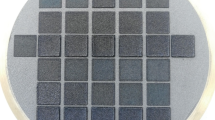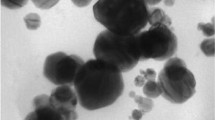Abstract
Near-net fabrication techniques are highly beneficial to minimize rare earth metal usage to fabricate dense fully functional magnets. In this study, feasibility of using the directed-energy deposition technique for fabrication of magnets is evaluated. The results show that despite the ability to fabricate highly reactive materials in the laser deposition process, the magnetic coercivity and remanence of the hard magnets is significantly reduced. X-ray powder diffraction in conjunction with electron microscopy showed that the material experienced a primary Nd2Fe17Bx solidification. Consequently, the absence of the hard magnetic phase resulted in deterioration of the build properties.




Similar content being viewed by others
References
Stadelmaier H (1990) J Mater Eng 12:185
Lewis LH, Jiménez-Villacorta F (2013) Metall Mater Trans A 44:2
Fidler J, Schrefl T (1996) J Appl Phys 79:5029
Croat JJ, Herbst JF, Lee RW, Pinkerton FE (1984) J Appl Phys 55:2078
Sagawa M, Fujimura S, Togawa N, Yamamoto H, Matsuura Y (1984) J Appl Phys 55:2083
Ma B, Herchenroeder J, Smith B, Suda M, Brown D, Chen Z (2002) J Magn Magn Mater 239:418
Brown D, Ma B-M, Chen Z (2002) J Magn Magn Mater 248:432
Hirose Y, Hasegawa H, Sasaki S, Sagawa M (1998) In: Proceedings of 15th International Workshop on REPM and Their Applications, Dresden, Germany
Sasaki S, Hasegawa H, Hirose Y (1999) Google patents
Gibson I, Rosen DW, Stucker B (2010) Additive manufacturing technologies. Springer, New York
Gu D, Meiners W, Wissenbach K, Poprawe R (2012) Int Mater Rev 57:133
Li L, Tirado A, Nlebedim IC et al (2016) Sci Rep 6:36212. https://doi.org/10.1038/srep36212
Li L, Post B, Kunc V, Elliott AM, Paranthaman MP (2017) Scripta Mater. https://doi.org/10.1016/j.scriptamat.2016.12.035
Gao J, Volkmann T, Herlach D (2002) Acta Mater 50:3003
Gao J, Volkmann T, Herlach D (2001) J Mater Res 16:2562
Gao J, Volkmann T, Roth S, Löser W, Herlach D (2001) J Magn Magn Mater 234:313
Gao J, Volkmann T, Yang S, Reutzel S, Herlach D, Song X (2007) J Alloy Compd 433:356
Li J, Liu Y, Gao S, Li M, Wang Y, Tu M (2006) J Magn Magn Mater 299:195
Volkmann T, Strohmenger J, Gao J, Herlach DM (2004) Appl Phys Lett 85:2232
Ozawa S, Kuribayashi K, Hirosawa S, Reutzel S, Herlach D (2006) J Appl Phys 100:123906
Schneider G, Henig ET, Petzow G, Stadlmaier HH (1987) Z Metallkde 77:755
Schneider G, Landgraf FJ, Missell FP (1989) J Less Common Met 153:169
Babu S (2009) Int Mater Rev 54:333
Umeda T, Okane T, Kurz W (1996) Acta Mater 44:4209
David S, Vitek J (1989) Int Mater Rev 34:213
Jacimovic J, Binda F, Herrmann LG, Greuter F, Genta J, Calvo M, Tomse T, Simon RA (2017) Adv Eng Mater. https://doi.org/10.1002/adem.201700098
Acknowledgements
This research (HU, MPP, SKM) was supported by the Critical Materials Institute, an Energy Innovation Hub funded by the US Department of Energy, Office of Energy Efficiency and Renewable Energy, Advanced Manufacturing Office. Work at LLNL under Contract DE-AC52-07NA27344. Part of this research was also supported by the US Department of Energy, Office of Energy Efficiency and Renewable Energy, Manufacturing Demonstration Facility Tech Proposal with Arnold Magnetic Technologies. Thanks are due to Jim Herchenroeder at Molycorp Magnequench for providing magnet powders for this study. Thanks are also due to Dr. Ling Li for valuable discussions.
Author information
Authors and Affiliations
Corresponding author
Additional information
Notice: This manuscript has been authored by UT-Battelle, LLC under Contract No. DE-AC05-00OR22725 with the U.S. Department of Energy. The United States Government retains and the publisher, by accepting the article for publication, acknowledges that the United States Government retains a non-exclusive, paid-up, irrevocable, world-wide license to publish or reproduce the published form of this manuscript, or allow others to do so, for United States Government purposes. The Department of Energy will provide public access to these results of federally sponsored research in accordance with the DOE Public Access Plan (http://energy.gov/downloads/doe-public-access-plan)
Rights and permissions
About this article
Cite this article
Sridharan, N., Cakmak, E., List, F.A. et al. Rationalization of solidification mechanism of Nd–Fe–B magnets during laser directed-energy deposition. J Mater Sci 53, 8619–8626 (2018). https://doi.org/10.1007/s10853-018-2178-7
Received:
Accepted:
Published:
Issue Date:
DOI: https://doi.org/10.1007/s10853-018-2178-7




